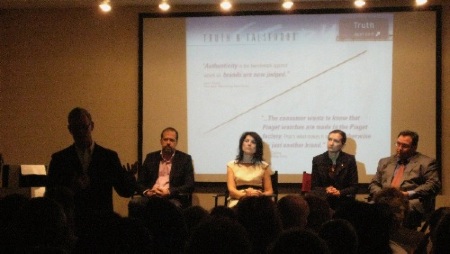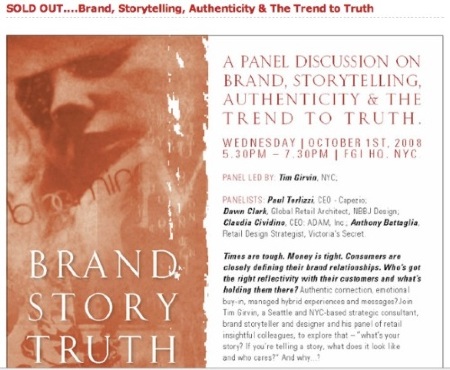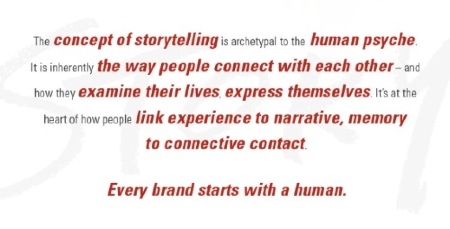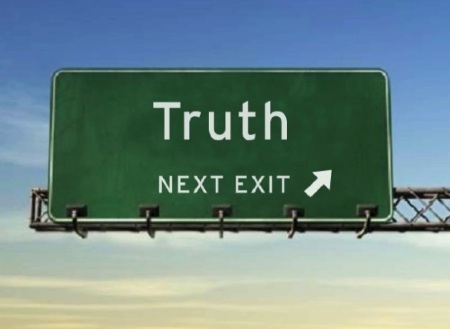
Panelists Anthony Battaglia, Claudia Cividino, Dawn Clark, Paul Terlizzi at Fashion Group International, NYC

I’ve been looking at, and looking for, working on, true brands. Brands that are true. True brands can’t be invented, they must be made in the context of truth-telling. Live what you are. Be all that you can be. And, more importantly, be what you are.
These times bode change — and truth, on many levels of experience, is about This past week I, along with Adam CEO, Claudia Cividino, Victoria’s Secret retail design strategist, Anthony Battaglia, global green retail designer and architect, Dawn Clark, AIA LEED AP, Capezio Brands CEO, Paul Terlizzi met to discuss trends in brand development, positioning and storytelling. The event was sponsored by the Fashion Group International Frontliners and held at their offices overlooking the NYC Public Library and Bryant Park.

To reference my impressions of the power of storytelling would be an understatement of consideration, application and study. I believe in story. Heart fully.

The concept of story is so pervasive in terms of how people connect with each other that it threads the very course of our being as members of any community. We shift from communion to community, from communications to commune all based on the versioning of story. My story, your story, our story — they are all reflective; they are all about inverting and converting the code of our being(s) and sharing them; our web, our way of thinking — purely the working of the mind is based on narrative.
And in anything, truth plays true.

But there’s a spread, to this mission. Story — and the emerging truth of telling — is everywhere. What’s the truth? It’s looking to the heart of your proposition and defining anew, what you stand for.

Every brand that I’ve connected with is either defining, or redefining, their credibility — and right now, this is something of profound importance. They seeking their truth; now’s the time — are they credible — do they abide by credo and credence — do they adhere to code? Consumers are held in the suspension of disbelief. Everything that they’ve worked for has failed — the economy, savings, the presence of Americans in the world; it’s all tumbling. Now’s the time to come clean.
And given the timeliness of exploration, moving to our forthcoming election focus, even our presidential aspirants are struggling to get the “right story” out. And politics is surely as much about storytelling as it is to relatedness. People react on instinct — making their decisions less on the absorption of facts and more on the reliance on gut “intelligence“.
“Voters have a sharp appetite for authenticity in this presidential election, and candidates are doing their best to deliver.” On the campaign trail and in books, John “Character Is Destiny” McCain, and Barack “Dreams From My Father” Obama all present their life stories as proof they embody a true American experience, says Paul Starobin in National Journal.
Robin Moroney offers: “Voters seek authenticity when they tire of the day’s dominant political style.” There’s a distinguishing character for the politician whose life and personality match their message — with no discrepancy between the public face and the inner self — will come across as authentic, according to Starobin, who traces the current yearning for authenticity to discomfort with Bill Clinton’s evasions about his personal life.
George W. Bush (and now, Sarah Palin) appealed to voters who preferred his (and her) folksy manner to his political opponents’ “synthetic” style. There are contrary evidences of the truth in telling — the sharp drop in Mr. Bush’s popularity ratings could be said to stem from his “authentically stubborn” handling of the Iraq War, among other things, dismally evidenced in his performance and the administration’s current command of truth-less-ness.
That same challenge in the public’s perception of McCain and Palin shall be “a difficult circle to square.” Patrick Ohlin comments that “when President Clinton lied to the American people about Monica Lewinsky, he did not so much harm his authenticity (in other words, his political stature and place in U.S. history) as change the public’s desire to wholeheartedly support his brand. In many respects, the event actually helped Clinton to rise above authenticity to icon status. For half of the populace, the Bill Clinton brand became more like them: accessible, human, frail, forgivable. For the rest, he crossed an irrevocable line of trust that he could never uncross. In the years since Clinton left office, his brand has regained value–not by harking back to tainted authenticity but, as was the case with other politicians before him, via well-placed efforts to reposition himself through newfound honesty and relevant good works.”
But it’s all about truth, in story — pardon the now historically relevant aside to politics (crucial, mind you).
He continues, to the front of authentic character, that “advertisers and politicians often say the importance of what you say and do is a matter of perspective. But in brand building, truth is singular and concrete, a cornerstone. So why are some marketing pundits clouding the waters by promoting authenticity as the primary driver of brands?”
But why? “Brand authenticity is itself an outcome—the result of continuous, clear, and consistent efforts to deliver truth in every touch point. Second, a brand can be authentic in either its positive or its negative character. That is the main problem: Not all authentic brands are honest. In the age of corporate scandals and lost retirement funds, a brand can be an authentic scoundrel.” And we’ve all seen that — in the tumult of what we are experiencing in the world of message and communications today.
When brands stay on message — and they deliver what is expected in the context of character, “there really is not much difference between truth and authenticity.” They are, to the least, etymologically aligned. How you deliver these assets to define relationships and community is at the heart of the artful science of brand development — they are an expected foundation. Ohlin, the leader of CoreBrand, a strategic consulting group, suggests that “Brand building means philosophically—and in practice—being truthful to oneself and to one’s major stakeholders, partners, and customers, seeking relevance and making promises you can keep.”
Every member of the panel discussion at FGI approaches this construct — Claudia Cividino talks about the real character — and the telling, the sharing — of Adam Lippes history, his experience, his legacy as a design director for Oscar de la Renta. And, in typical Cividino quality — based on my personal observations of her at Yves Saint Laurent, and profound hands on care of every aspect, every detail of the brand and the telling of the story. Of him. Paul Terlizzi references “custom” — making something special for a client — that tells something to the legacy of the story of the founding cobbler, Salvatore Capezio. And it’s all about the story. Anthony Battaglia refers to leading his clients into the procession of experience in layering of story in Victoria’s Secret — following in the strategically founded steps of Lesley Wexner, legendary merchandiser (who once told me “if a passer by doesn’t get your story to the degree that they come in, then you’ve got to rebuild the story of your shopfront to bring them in”). And Dawn Clark, visionary retail architect, defines story as the “truthfulness of experience” — it’s spinning the story in design that captivates, “entrancing the vision of retail” retelling. Each panelist, their own take on the meaning, but in all, a collective unity.
What happens?
• People are looking for the truth — from a brand that’s 125 years old, to a newly developing enterprise, consumers are more discerning and capable of either linking in, or linking out of a brand relationship.
• Thinking of brand as a story — is a way of developing relationships with consumers. If there’s a connection between a person, and their empathic connection to a brand, it’s their story, that relationship.

• People — designers, fashion leaders, founders, present visionaries, people are at the heart of the DNA of the brand. Examples to reference? Steve Jobs lives at the center of Apple’s coding, Adam Lippes is the vision spark of Adam, the spirit of Salvatore Capezio — living on in brand vision for Capezio? The Nordstroms are at the center of Nordstrom, Hermés family — that brand. Tom Ford — is Tom Ford. Diane Von Furstenberg and Chanel — what story, what strategic link between these people, the past, the present, the future? These are stories.
• And they filter out in many ways — from strategic and visioning expressions, to PR tellings, creative action and design. How’s that story told? Retail design? Web strategy. Advertising? Fashion show? All, and more…
— Stories, people relate to them – they are the heart and soul of the human way of communicating — I tell you a story about me, and in all likelihood, that will be what you remember; narrative is fundamental to the way people connect.
— One story becomes another story. Facebook, MySpace, LinkedIn — these are all about communities of story.
— What’s the point? Thinking about branding — there are applications.
That, inherently, would be the nature of the exploration. <font color=”red”Truth: Ideas, answers, directions.
That’s what we explored. Standing room only.

October 1st, 2008.